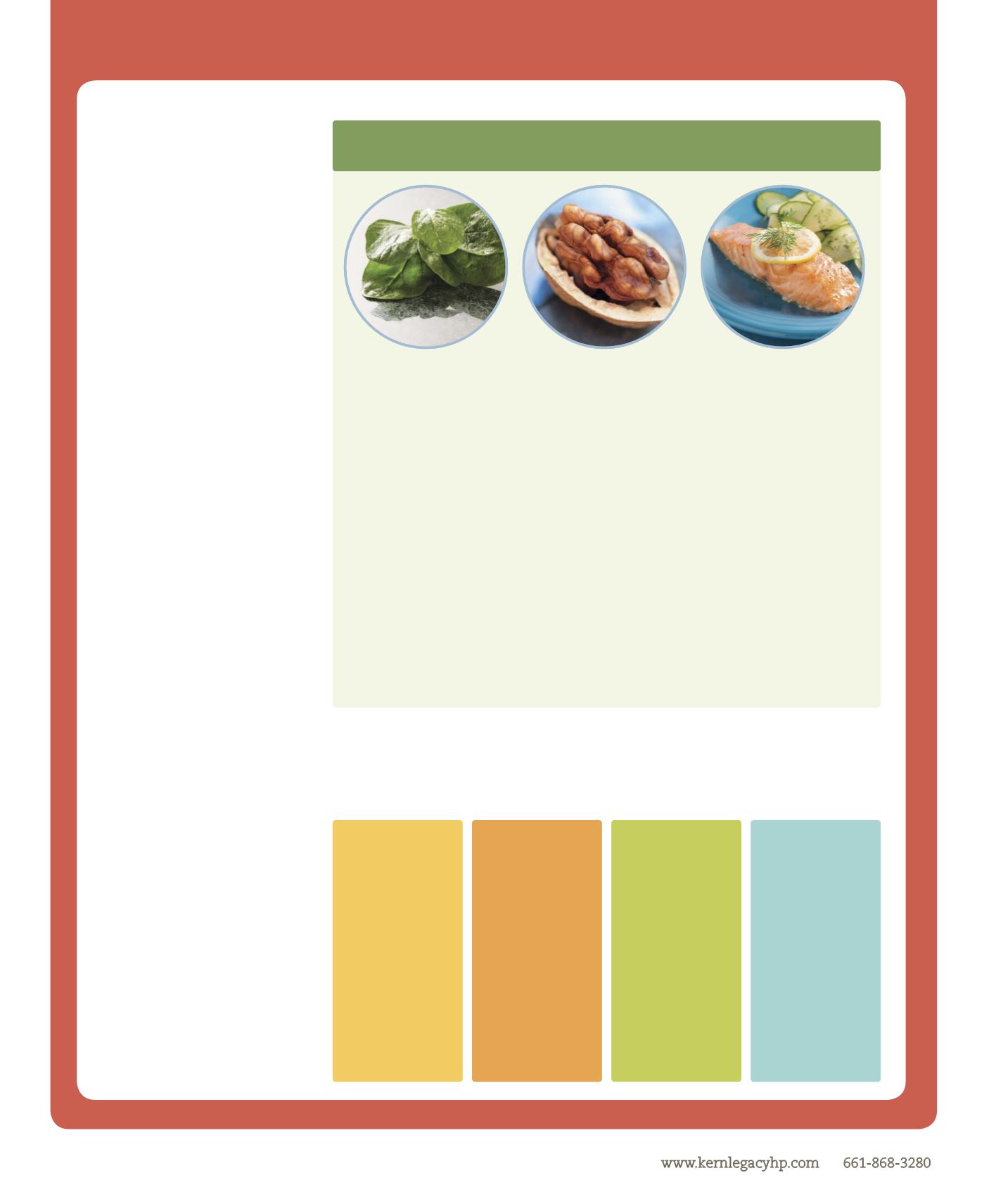
A trio of heart-smart foods
Spinach.
Slip some into
your next sandwich or
omelet, or enjoy it solo
as a salad. However
you use it, Popeye was
right: This bright green
veggie is good for you—
especially your heart. Like
other produce, it lowers
cholesterol. Plus, it has the
extra advantage of being
a super source of potas-
sium, which helps bring
down blood pressure.
Walnuts.
Some fats are
good for your heart.
And walnuts are rich in
polyunsaturated fat, a
beneficial kind that lowers
cholesterol levels. They
also contain omega-3 fatty
acids, which reduce heart
attack risk. Go a little easy,
though—walnuts are
high in calories. Fourteen
walnut halves make up a
single serving.
Salmon.
Fatty fish like
salmon are especially high
in omega-3 fatty acids,
which appear to lower
your risk of dying from
heart disease. Along with
reducing heart attack
risk, they protect against
blood clots and high
blood pressure and they
lower triglyceride levels.
So why not treat yourself
to salmon—or another
fatty fish, such as tuna or
mackerel—tonight?
Source: Academy of Nutrition and Dietetics
Know your
risk factors
More than 15 million Americans
have coronary heart disease
(CHD), according to the American
Heart Association (AHA). Could
you be one of them? Only your
doctor can tell you for sure. But
looking at your risk factors may
give you some clues.
A man’s risk goes up after
age 45, and a woman’s risk goes up
after age 55, the National Heart,
Lung, and Blood Institute reports.
Risk also increases if heart disease
was diagnosed in your father or
brother before he turned 55 or in
your mother or sister before she
turned 65. These are risk factors
you cannot change. But there are
several risk factors you can do
something about:
w
If you smoke, quit. You should
also try to avoid exposure to sec-
ondhand smoke.
w
If you’re overweight or obese,
try to lose weight.
w
If you don’t get much exercise,
talk to your doctor about the best
ways to become more physically
active.
w
If you have high blood pressure,
high cholesterol or diabetes, work
closely with your doctor to control
these conditions.
The more risk factors you have,
the more likely you are to develop
CHD. But keep in mind, a high risk
doesn’t necessarily mean you’ll
have a heart attack. With your
doctor’s help, you may be able to
bring down your risk.
For a more detailed way to
estimate your risk of having a
heart attack in the next 10 years,
visit the AHA website at
Know your numbers
Unsure what cholesterol numbers you should be aiming for to stay heart-healthy?
The ranges shown here are general guidelines. Talk to your doctor about what’s right for you.
Total
cholesterol
w
Desirable: Less
than 200 mg/dL.
w
Borderline high:
200 to 239 mg/dL.
w
High: 240 mg/dL
and above.
HDL (good
cholesterol)
w
Protective
against heart
disease: 60 mg/dL
and above.
w
At risk for heart
disease: Less than
40 mg/dL for men,
less than 50 mg/dL
for women.
LDL (bad
cholesterol)
w
Optimal: Less
than 100 mg/dL.
w
Near-optimal:
100 to 129 mg/dL.
w
Borderline high:
130 to 159 mg/dL.
w
High: 160 to
189 mg/dL.
w
Very high: 190
mg/dL and above.
Triglycerides
w
Normal: Less
than 150 mg/dL.
w
Borderline high:
150 to 199 mg/dL.
w
Very high:
500 mg/dL and
above.
Sources: American Heart
Association; National Heart,
Lung, and Blood Institute
661-868-3280
w
3


